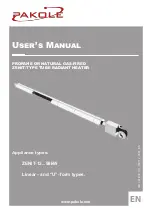
- 12 -
2.5
TANK CLEANING AND ANODE ROD EXCHANGE
Repetitive water heating causes limestone sediment on both the enamelled tank walls and chiefly the flange
lid. Lime scale settling depends on hardness of heated water, its temperature and on the volume of hot water
used.
We recommend checking and cleaning the receptacle from lime scale and eventual replacement
of the anode rod after two years of operation.
The anode life is theoretically calculated for two years of operation; however, it changes with water hardness
and chemical composition in the place of use. Based on such an inspection, the next term of anode rod
exchange may be determined. Have a company in charge of service affairs deal with the cleaning
and exchanging of the anode. When draining water from the tank, the combination faucet valve for hot water
must be open, preventing the occurrence of under-pressure in the tank receptacle which would stop water
from draining.
To prevent the occurrence of bacteria (e.g. Legionella pneumophila) within stack heating
it is recommended, if absolutely necessary, to increase the temperature of hot service water
(HSW) periodically for a transitional period of time to at least 70
℃
. It is also possible to make
use of another way of disinfecting HSW.
PROCEDURE OF EXCHANGING ANODE ROD IN UPPER PART OF THE TANK
1.
Turn off control voltage to the tank
2.
Drain water from 1/5 tank.
PROCEDURE: Close water inlet in the tank
Open the hot water valve on the combination faucet.
Open the drain tap of the tank
3.
Anode is screwed in under the plastic cover in the upper lid of the tank
4.
Unscrew the anode using adequate wrench
5.
Pull the anode out and follow reversed steps to install a new one
6.
During the assembly, make sure the ground wire (300 l) is connected properly; it is essential
for proper anode function
7.
Fill the tank with water
PROCEDURE OF EXCHANGING ANODE ROD IN SIDE FLANGE
1.
Turn off control voltage to the tank
2.
Drain water from the tank.
PROCEDURE: Close water inlet in the tank
Open the hot water valve on the combination faucet.
Open the drain tap of the tank
3.
One anode is screwed in under the plastic cover in the upper lid of the tank, and the other one
is screwed in on the side flange
4.
Unscrew the anode using adequate wrench
5.
Pull the anode out and follow reversed steps to install a new one
6.
Fill the tank with water































